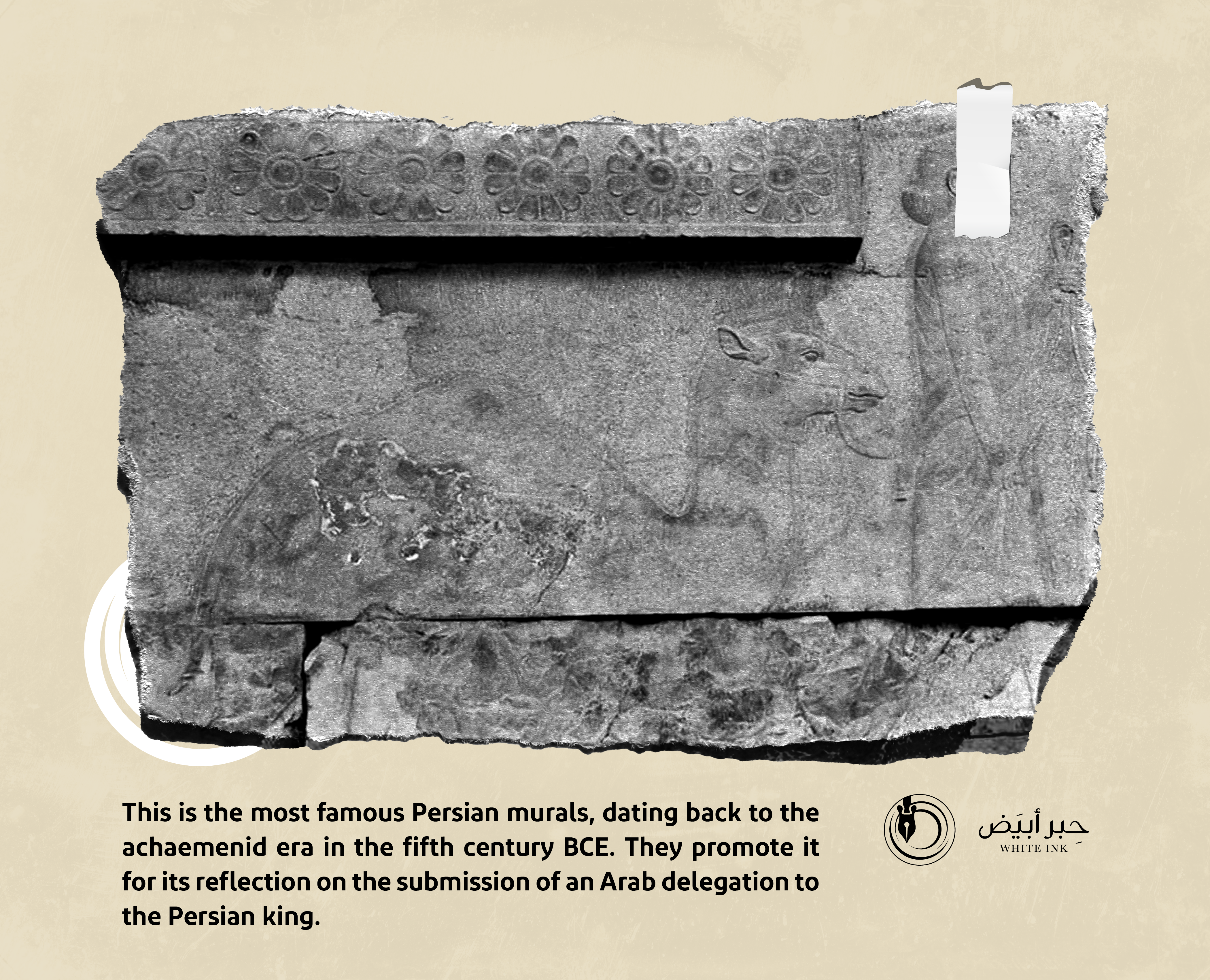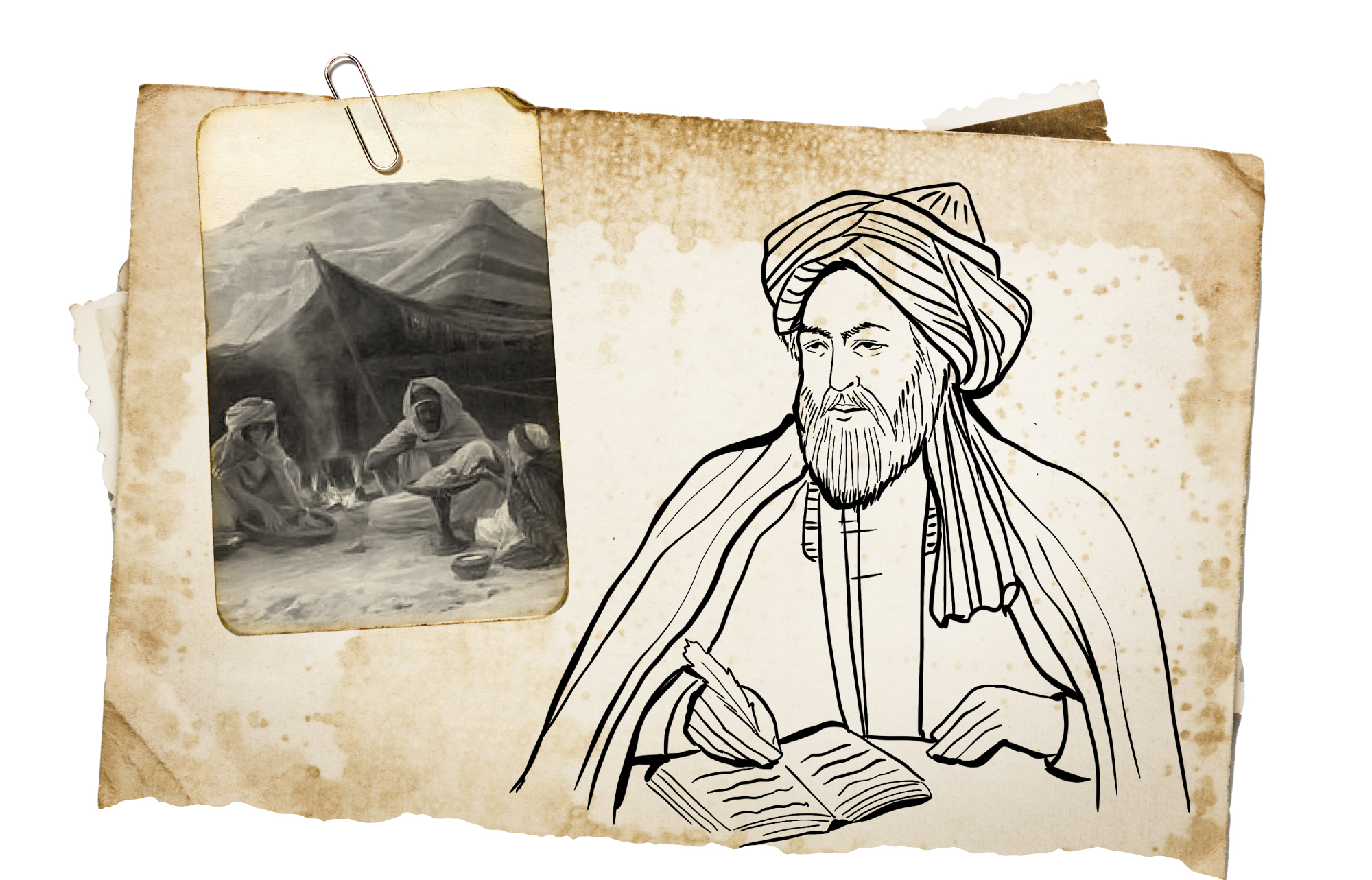
Nasir Khosrow as a model
Persians Did Their Best to Promote Ethic Works and Writings in an Attempt to Underestimate Arabs
Since early period, the Persian agenda against Arabs went through stages and transformations as it transferred from war fields to book pages. Thus, the hostile behavior moved to the level of literary production confirming the continuity of the racial psychological state, and the ideology of ethic superiority which contradicts with the human principles, and that is opposed to common sense.
In this context, Safavids worked hard to promote only certain works and writings with the aim of transforming natural manifestations into a part of the Persian view of the Arabs and ascertain the inferiority of the Arab race that brought the Persians out of the darkness of ignorance and the pre-Islamic perceptions to Islam. If Muslims, in general, were accustomed to traveling and roving lifestyle to perform the Hajj or engage in trade, in addition, some of them were dedicated to educational attainment, some of them exploited their movements to perceive the landmarks of countries and the returns of the cities; and to compare them with the environment in which they lived.
Some of those who are considered Persians left the objective argument and thoroughly studied subjectivity that drove them to depicting a negative image of Arabs and use it to ascertain an arrogant racist ideology that gave advantage to the Persian treatment and point of view towards the rest of races and ethnicities.
Such works include the book titled “Safar Nameh” by Nasir Khosrow, who ascertained the racist nature what prompted us to search in the pages of this book in order to complete the image corners and help to better understand the Persian behavioral structure. In (1047), the Persian poet and philosopher Nasir Khosrow left the city of Merv on one of the oldest and most important journeys in the Middle Ages. It took seven years during which he toured the inhabited areas of Iran and went from there to Azerbaijan, Armenia, the Levant, Palestine, Egypt and the Arabian Peninsula.
During his journey to the Arabian Peninsula, he could not restrain himself from exaggeratedly writing about and describing Arabs; in addition to some false information which he wrote during his journey. This includes, for example, the tomb of Abu Hurairah, may God be pleased with him, which he claimed to be in Tiberias on contrary to reality and into which he insinuated racist thought about Abu Hurairah, saying, “The tomb of Abu Hurairah is located outside Al- Madina towards the Qibla. However, no one can visit it; because the residents there are Shiites, so if someone went to visit it, children gathered around him, harassed him, discriminated against him and threw stones at him.” Although the tomb is in Al- Madina Al- Munawara, the deep meaning of Khosrow’s statement is to ascertain the ideology dimension according to the Persian manner. In addition, choosing Abu Hurairah in particular has a lot of purposes as he is one of hadith narrators who narrated most of the Prophet’s hadiths, may God be pleased with him.
In general, the writing of Khosrow was enriched with the ethnic style, translating the Persian view towards Arabs, in spite of his recognition of the Arabs’ generosity and their preferential treatment towards him. This includes his saying, “The Emir of Jeddah is subordinate to the Emir of Mecca who was the Emir of Al- Madina too. In addition, I went to The Emir of Jeddah and he treated me with great generosity, and exempted me from duties which I had to pay, but he did not demand them… He wrote to Mecca saying about me: This man is a scholar, so nothing should be taken from him. However, instead of thanking the host for his hospitality and protection, he detracted the Arabs of Banu Nusair fortress saying, “During their whole lives, they have tasted nothing but camel milk because this desert has nothing but rotten fodder which the camels eat. Thus, they thought that this was the world.” His wording comprised clear underestimation of Arabs and an indication that was rather a statement similar to the Persian point of view and their stereotypical image of Arabs.
Khosrow described the Arabs of Aflaj saying, “The construction was limited to half a Farsakh (league) in a mile in width. In such distance, there were fourteen castles, a castle for thieves, corrupters, and ignorant people… In addition, they only ate a little from Maghrib prayer to the following Maghrib prayer… People there are very poor and miserable. In spite of their poverty, they are engaging in war, hostility and bloodshed”. The exaggeration included in the writing of Khosrow was, of course, only a simulation of the stereotype instilled in the Persians, rather than a reality he described.
Arguably, the image depicted by Nasir Khosrow about Arabs was dominated by prejudice and insolence what raises a question about such prejudice and insolence. Khosrow summarizes his prejudice against Arabs saying, “I think that all Bedouins are like the people of Al- Ahsa who have no religion. They include people whose hands have not touched water for a year… And they have never seen bathrooms or running water in their lives”.
Trying to trace Khosrow’s description, in general, we will find that he does not deviate from this racist framework that is prejudiced against the Arab race, as he neither left any chance for criticism, nor any incident without undermining and exaggerating it, especially if it leads to showing Arabs as backward ignorant people. He treated the life of the Arab Bedouin as flawed, without realizing that Arabs themselves are proud of their Bedouin life, which is considered the basis for the lives of many of them. If he only saw it as living in the desert and drinking the camel milk, then, it is hard for him to perceive that those Arabs including their Bedouins and urban inhabitants, have value and honor that is difficult to be viewed in the Persian reality, life, and treatments.
Arabs, including their Bedouins and urban inhabitants, have values and honor that is difficult to be viewed in the Persian reality, life, and treatments.

This is the image that Persians try to instill in the collective imagination of Iranians. Then, they continue feeding them hatred and arrogance which can only be interpreted as it is the Persian desire to create a virtual enemy of their nationalism, through which they pass their internal agendas. They also try to prove unrealistic civilized manifestations of Persia.


- Raif Khoury, With the Arabs: In History and Legend (Cairo: Hindawi Foundation, 2019).
- Abd Al- Wahhab Azzam, The links between the Arabs and the Persians and their Etiquette in the Pre- Islamic Era and Islam (Cairo: Hindawi Foundation, 2012).
- Mohammad Al-Salami, The Arab Other in Modern Iranian Thought (Riyadh: International Institute for Iranian Studies, 2018).
- Nasir Khosrow, Safar Nameh, traslated by: Yahya Al-Khashab, ed.2 (Cairo: The Egyptian General Authority, 1993).
- Homa Katouzian, The Persians: Ancient, Mediaeval and Modern Iran, translated by: Ahmad Hasan Al- Ma’ini (Beirut: Dar Al- Jadawel, 2014).
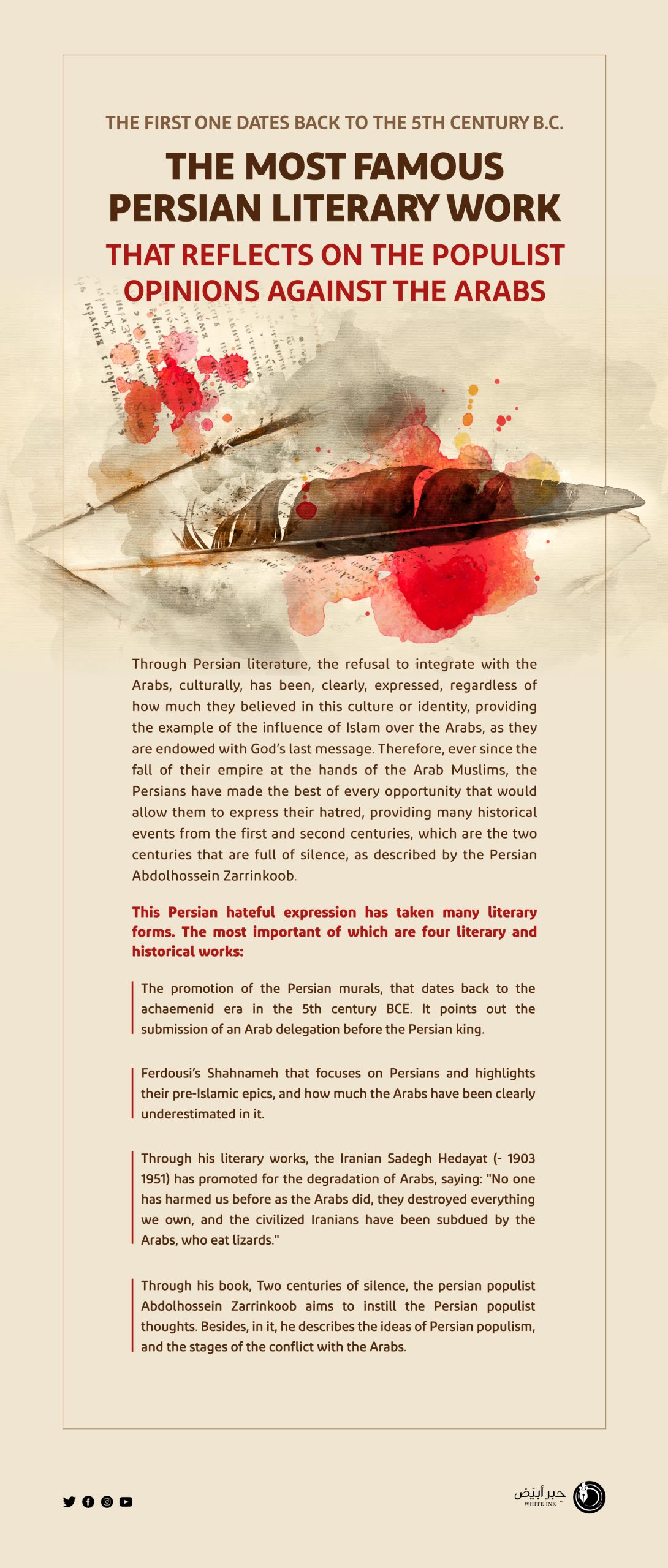
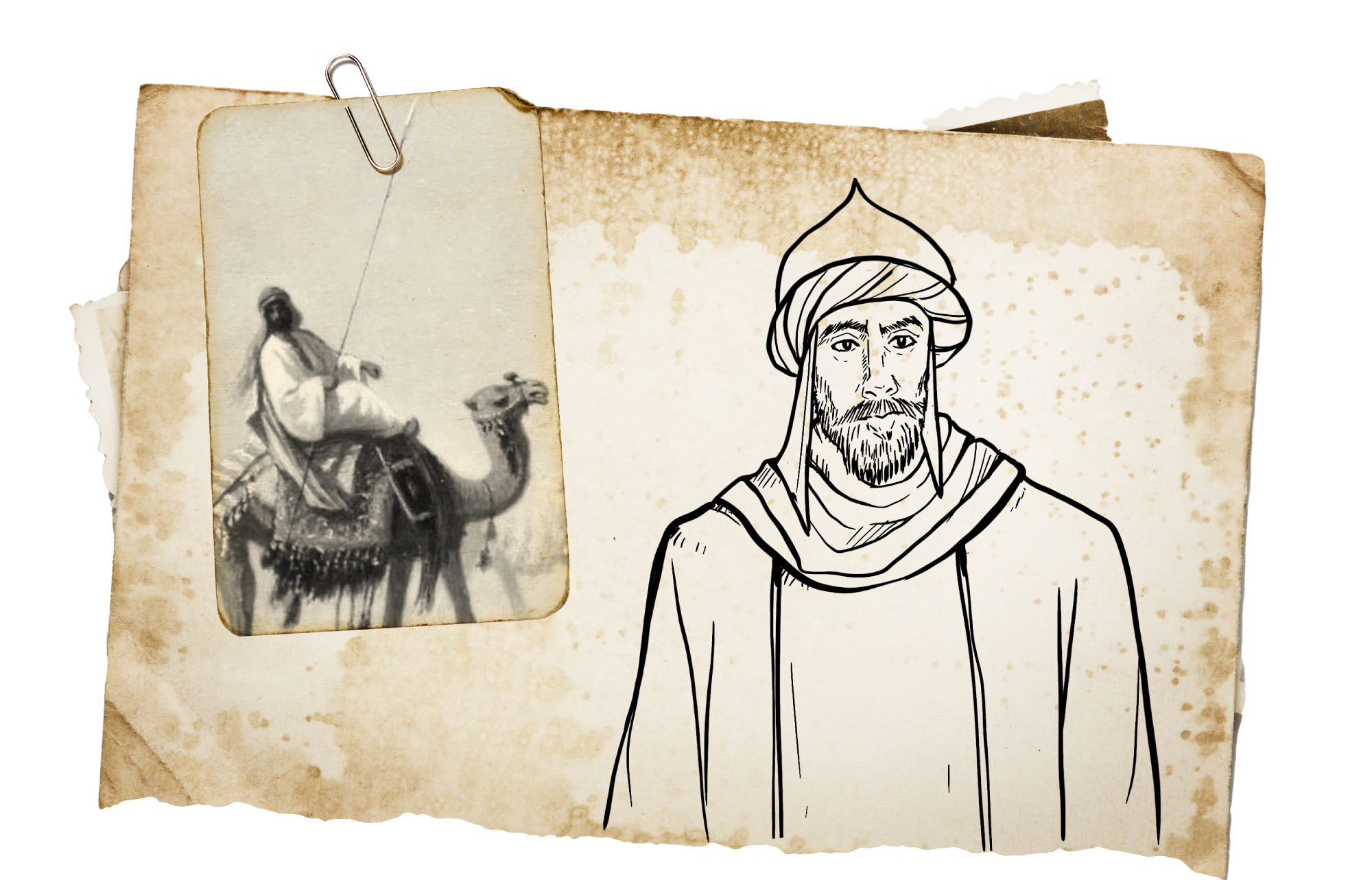
Populism
A Persian racist thought that grew on hatred of the Arabs
Populism is considered one of the most dangerous extremist movements in the Islamic history and it is an anti-Arab movement throughout Persia. Some attributed the origin of the word to the word people, meaning the bias and fanaticism of a particular people, in particular the Persians, and the rejection of Arab rule, as well as the desire to revive the Persian language and the ancient pagan religions.
The Iraqi Abdul Aziz Al-Douri is considered the most prominent person who studied the phenomenon of populism in Islamic history. He explains populism as: “All of the secret movements that pretend to belong to Islam and work to destroy the Arab-Islamic rule or it is the trends that work to destroy Islam from within”. The pioneer of Persian studies, Abd Al-Wahhab Azzam, refers to populism as: “the remnants of religious and ethnic fanaticism of the Persians”.
The populist movement began in the last periods of the rule of the Umayyad state, as the Persians viewed the Umayyad state as representing the rule of the Arabs, the desert dwellers, whom the fanatical Persians considered to be the ones who brought down the Sassanid state, the last Persian empire. Accordingly, some believe that the joining of the Persians, especially the people of Khorasan, to the Abbasid call was for the purpose of overthrowing the Umayyad state and reaching the rule through the Abbasid state. These historians referred to what one of the supporters of the Abbasid call with Abu Muslim Al-Khorasani said, who is Qahtaba Ibn Shabib Al-Tai, when he reminded the people of Khorasan of their great history and how Allah empowered the Arabs over them and their oppression intensified, so Allah empowered the people of Khorasan over the Arabs to take revenge on them.
Persian populism overthrew the Umayyads and struggled with the Abbasids by integrating anti-Arab ideas, beliefs and methods.

Thus, the Persians viewed Abu Muslim Al-Khorasani, the Persian leader who contributed to the overthrow of the Umayyad state and played an important role in governance at the beginning of the Abbasid state, as one of the figures of Persian nationalism. Some considered him as the successor of Zoroaster, and others considered him the savior who had some of the divine spirit.
The populist movement was characterized by an extremist religious character, especially those who were historically called as “extremists”. These are a Persian group that revived the Magian concepts and beliefs under an Islamic cover. They exploited the love of the family of the Prophet and the Alawite call as a religious cover to confront any existing Arab authority, especially the caliphate. There are many religious groups for the extremists, but they all base their beliefs on Zoroastrianism, Mazdakism, and Manichaeism. Some groups of extremists depend on one of the previous religions, and some depend on a mixture of the ideas of all these religions.
Populism was not satisfied with its religious dimension, but also extended to the fields of literature in an attempt to contest the Arab culture that had spread and prevailed in Persia. Supporters of populism worked on reviving the Persian language again, limiting the use of Arabic as a literary language and belittling its importance and the importance of the Arabs in general.
Among the most famous of these anti-Arab populist writings is what was written by the Persian populist Allan Al-Warraq. Although he was one of the scribes in the House of Wisdom in Baghdad during the time of Al-Rashid and Al-Ma’mun, he wrote the book “Al-Maydan Fi Al-Mthaalib”. Ibn Al-Nadim said that: “In this book, he insulted the Arabs and showed their defects”. He also wrote several books about the defects of Quraysh. Al-Jihani also went on to describe the Arabs as: “They eat jerboas, rats, and serpents, and they also gossip, fight and commit immorality”.
Populism took on a political dimension, especially with the success of the Persian Khorasani, Taher Ibn Al-Hussein, in forming the first Persian emirate after the Islamic conquest of Persia, which was known as the Tahirid state, which is a hereditary emirate. Some describe him as: “He is Khorasani who is enthusiastic about his Persian race and does not feel comfortable with the Arabs or with Al-Ma’mun, his master”.
We also find another leader, such as Al-Afshin. Although he is a Muslim, he keeps the ancient Persian religious books. It is said that he was not circumcised according to the custom of Muslim males and he hated the Arabs a lot.
The matter reached its climax in the era of the Samanid state, when a fatwa was issued authorizing prayer in Islam in the Persian language in an attempt to weaken the spread of Arabic.
Abdul Aziz Al-Douri ends his important study on populism in Islamic history with an interesting and important result about the persistence of populism until now. He says: “This does not mean the demise of populism, especially since its materials and components are still present and it is waiting for the right conditions to continue its activity”.


- Hussein Atwan, Infidelity and Populism in the First Abbasid Era (Beirut: Dar Al-Jeel, 1984).
- Abdul Aziz Al-Douri, The Historical Roots of Populism, 3rd Edition (Beirut: Dar al-Tali`a, 1981).
- Abd Al-Wahhab Azzam, The Links between Arabs and Persians and Their literature in Pre-Islamic Times and Islam (Cairo: Hindawi Foundation, 2013).
- Abdullah Al-Samarrai, Populism is a movement against Islam and the Arab nation (Baghdad: Dar Al-Rashid, 1980).
- Nima Al-Azzawi, Essays on the impact of populism in Arabic literature and its history (Baghdad: Cultural Library, 1982).
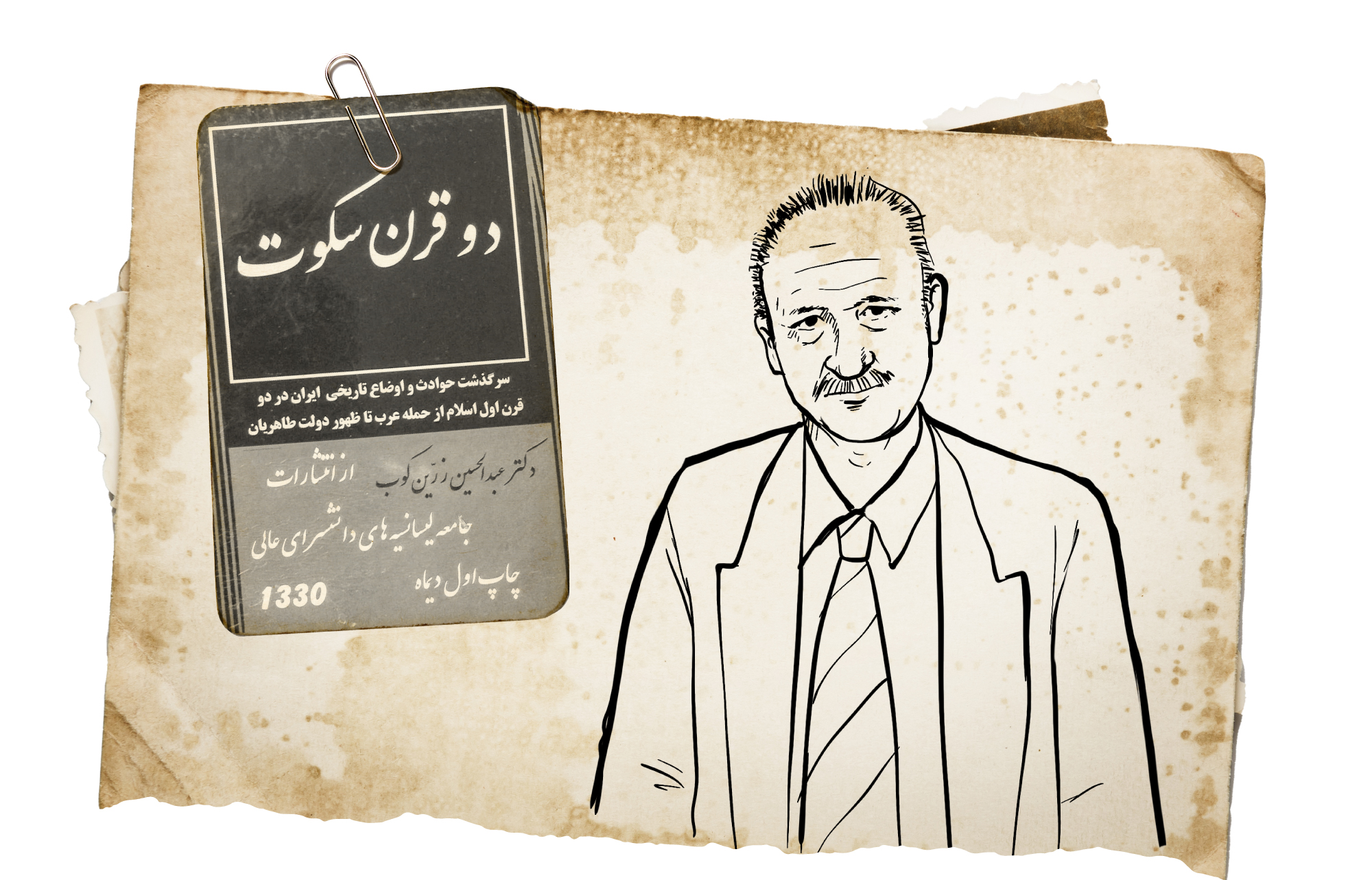
The book “Two Centuries of Silence” expresses that
Why did the Persians refuse to merge with the Arabs into one identity?
The appearance of the book “Two Centuries of Silence” by the Persian Abdul Hussein Zarin Kobe at the end of the fifties of the last century was not an exception in the Iranian anti-Arab literature, but was a real extension of it and a declaration of what is going on behind the scenes of the Iranian elites, and even the popular culture in which the hostility has been rooted for centuries towards everything that belongs to the Arabs.
The book considered that Iran entered a state of silence during the first two centuries of Islam, which is an unfair accusation to those two centuries which the Messenger, may Allah bless him and grant him peace, praised, saying: “The best of centuries is this century and the next”. The Persians, who hated everything belongs to the Arabs, describe them as the two centuries that followed the defeat of the Sassanid Persian Empire by the Muslims in the Battle of Nahavand (Nahawand). In his book, Abdul Hussein condemns Iran’s conversion to Islam and accuses Arab leaders and rulers of suppressing Persian culture and obliterating its sources.
The book “Two Centuries of Silence” excluded the Abbasid era from that when it announced the end of the “Age of Silence” with the end of the era of Harun Al-Rashid and the victory of Caliph Al-Ma’mun and his Persian supporters over his brother Al-Amin, and then the rise of the Persians to high positions in the army and the Abbasid palace. Thus, Persian nationalism began to rise again. Indeed, Abdul Hussein Zarin Kobe describes the Abbasid civilization as a purely Persian civilization.
Many Persians believe that the Abbasid era brought about a change in the course of history in their favour. This theory is based on a dark view in which they judge the first two centuries of Islamic history with cruelty and racism, and portray them as years of silence and isolation that prevailed in Persian culture and only it was liberated when the Abbasid Caliph Al-Ma’mun came to power after defeating his brother Al-Amin. Two centuries of cultural isolation that was imposed by force on Persia, as they claim, and was called in the writings of many of them, two centuries of silence.
The Persians refused to integrate into Islam
The Persians only found a way to resist Islam through Persian cultural isolation and remain on alert until they could restore it with all its religious myths and Sassanid dreams. They were able to achieve this with the beginning of the Abbasid era when they infiltrated the Palace of rule and were able to do so. In a research published in the Lebanese newspaper Annahar under the title “The Arabs and The Persians between Integration and conflict”, Mahmoud Al-Zibawi asserts that Abdul Hussein Zarin Kobe, in his book “Two Centuries of Silence”, embodies the racist Iranian nationalist trend and the Persian pride that makes the Islamic civilization just a Persian civilization. This book was published at the end of the fifties of the last century and achieved wide public success, in which the author sought to highlight the silence of Iran during the two centuries that followed the Islamic conquest of Iran following the defeat of the Sassanid Empire in the Battle of Nahavand. The writer condemns the Islamic conquest of Iran, and accuses the Arab leaders and rulers of suppressing the local Persian culture and obliterating its sources. On the other hand, the Persian author adopts the orientalist saying that makes the Umayyad rule an Arab rule and the Abbasid rule a Persian rule and makes the Abbasid civilization a purely Persian civilization.
Why do the Persians consider the Abbasid era a Persian era?
Abdul Hussein Zarin believes that the Abbasid era, especially since the rule of Al-Ma’mun, is the beginning of liberation from the ages of silence that hindered the Persian civilization, according to his opinion. This is because the Persians penetrated the structure of the Abbasid regime and took control of it despite the presence of the Caliph Al-Ma’mun, and they were able to penetrate the state’s facilities after that. In a research published by Khaled Bashir on Hafryat website, he says: At the level of intellectual and literary movement, the new stage witnessed the emergence of the trend known as populism, which is the trend that tried to refute the superiority of the Arabs, which was considered a reaction to the Arab nationalist theses that spread and prevailed throughout the Umayyad era.
The populist movement cherished the Persian heritage, called for its revival, and raised the slogan of the superiority of other peoples over the Arabs in response to the Arab tendency that sees the Arabs as the best of nations. There are populists who have gone beyond that. In his book “The Misers”, Al-Jahiz talks about a group of populists called “Azadmurds” who hated the Arabs and saw that they had no preference over the non-Arabs. He says about them: “They are the most fanatic of the Persians”.
The image of the Arab in the mind of the Persian
In her book “The Image of the Arabs in Modern Persian Literature”, Joya Blondel Saad says about the Arabs in Persian literature: “The image of the Arabs appears as part of the answer to the question of the Iranian identity, as the concept of Iranianism formed a literary concern, rather a political and social problem that was reflected in literature as a problem of searching for historical, cultural and national identity. The writers of modern Iranian Persian literature resorted to portraying Iran as one nation by defining the Arab as the other, which is an inverted definition of the Iranian as being the origin in terms of race and language sometimes, and from the perspective of the other using the expressions of religion, history and culture at other times. It is a pattern that formed an aspect of Iranian nationalism in the last twentieth century”.
The author believes that Iranian nationalism is a clear value in modern Persian literature that we capture by describing social and local history, customs, dialects, and other things. Nationalism means loyalty and devotion to the nation. According to “Shahrokh Maskoub”, since the advent of Islam to Iran, the Iranian national consciousness has been based on the Persian language and on pre-Islamic history, given the factors of history and language. Accordingly, Iran was defined as a nation through the common language and history, but the reality indicates that Iran is a country of great ethnic diversity, there are Persians, Kurds and Arabs.
How did they describe the Arabs?
Joya Saad adds: “With the onset of modern national consciousness in Iran, secular thinkers sought to establish a new definition of the concept of “Iranianism” based on its pre-Islamic past. Some of them portrayed Iran as the Sassanid and Achaemenid empire which civilization was destroyed by the savage Bedouins”. The Iranian Mirza Agha Kermani sees Islam as a strange religion that was imposed on the noble Aryan nation (the Iranians) by a group of lizard eaters, barefoot and naked Bedouins living in the desert, describing them as the savage Arabs.
History does not tell lies
The relationship of the Arabs with Persia was going on two different paths. The Arabs dealt with the Persians as part of the Islamic nation, regardless of their character, and this prevailed with the Romans, Copts, Sindh, Afghans and other races that merged with the Muslim Arabs to form one nation. On the other hand, the Persians or some of them remained lamenting over Khosrau and his state, which had collapsed in the Great Battle of Al-Qadisiyyah. This incident remained an obstacle to their integration into the great nation, and many of those tried to remain Persian to this day.
In a deep study published by the Levant Writers Association on the image of the Arab Muslim in Iranian school curricula, we find that it does not differ from the context of Persian hostility and arrogance that is prevalent in most literature, prose or poetry. They imagine that the Arabs are responsible for the failure of Persian civilization. The truth is that this is not because of the Arab Muslims, as they claim, but the historical truth confirms that the Persians do not have the tools of civilization that should enable them to build their civilizational reputation away from Islam.
This Persian attitude against the Arab culture is not only scattered in the school curricula, but is also the attitude of the great writers of the ancient Persian heritage. The Shahnameh, the famous epic of Al-Ferdowsi, ends with sadness because of the advent of the Muslim Arabs and the elimination and occupation of the Sassanid state, in which the Arabs were portrayed as less civil than the Persians.
On this basis, Al-Ferdowsi composed his epic, which is devoid of any poetic sense, and he called it the Shahnameh meaning the king of books, using most of it in insulting the Arabs and glorifying the Persians and their kings. The Persian racists began teaching these hostile poems to their children.
The clash of civilizations began with the message of the Prophet, may Allah bless him and grant him peace, to Khosrau.
Dr. Nabil Al-Atoum says: “The Persians did not accept the Arabs in the past. How can they accept them after Allah assigned them to call for Islam? Therefore, we find that when the Prophet Muhammad sent a message to Khosrau inviting him to Islam, he became enraged and tore up the message. That happened when he heard the first words in the message where the name of the Prophet Muhammad was mentioned before his name, so he got angry and tore the message and said: A slave from my followers mentions his name before my name!”.
Only a few years passed until the Muslim armies were able to eradicate the myth of the Persian state during the era of the Caliph Umar Ibn Al-Khattab, may Allah be pleased with him. Since this defeat, Persian populism against the Arabs began and reached its climax when Abu Lu’lu’a assassinated Caliph Umar, who laid the foundation of the Arab Islamic state. The Persians still make pilgrimages to the shrine of Abu Lu’lu’a in Iran, and they call him “Bābā Shujāʿ al-Dīn” because he avenged the Persians after the defeat of Al-Qadisiyyah by killing Umar Ibn Al-Khattab.
Khosrau's attitude towards the message of the Prophet Muhammad, may Allah bless him and grant him peace, was the first populist expression in which they rejected the Arabs with arrogance.

With the advent of Islam to Iran, the Persians stubbornly adhered to their Persian culture and language and placed their nationalism parallel to and perhaps above their religion. This is what clearly reveals the phenomenon of hostility inherent in the structure of the Persian-Iranian mind against the Arabs, even though this historical conflict was supposed to end after the two parties entered under the banner of the Islamic religion. The Islamic conquest of Persia had a profound impact on the psyche and mentality of the Persian Magians, which in turn formed a painful psychological complex that is the eternal glory of the Persians. Until that date, the Persians considered themselves the masters of the world. Since ancient times, the Persian mentality has been associated with the desire for absolute control and political influence over the lands of Iran, Iraq, the eastern Gulf and some western parts of it, and Yemen. This created what could be called the Persian arrogant view over all peoples, including the Arabs.
The truth is that the Persians, from the first moment until now, have refused to fully integrate into the comprehensive Islamic identity and have always sought and still seek to avenge their historical defeat by the Arabs. That is why they rushed quickly to adopt the Safavid call, which transformed Iran from a Sunni state into the first Shiite state in Islamic history. Their aggressive behavior has continued throughout time regardless of the nature of the rule in Persia.


- Joya Saad, The Image of the Arabs in Modern Persian Literature (Damascus: Cadmus for Publishing and Distribution, 2007).
- Nabil Al-Atoum, The Image of Arabs in Iranian School Books (Amman: Umayya Center and Dar Ammar, 2015).
- Khaled Bashir, “How do the Persians view Arabs?”, Hafryat website, at: https://hafryat.com
- Mahmoud Al-Zibawi, “The Arabs and The Persians between Integration and conflict”, Annahar Newspaper (2014), at: https://www.annahar.com



